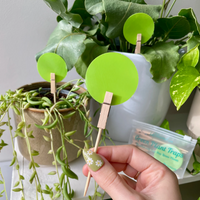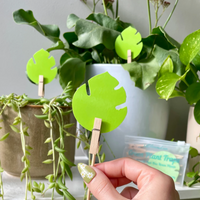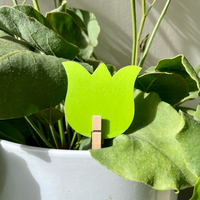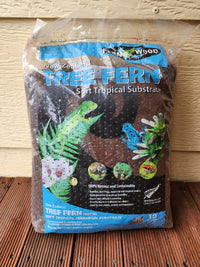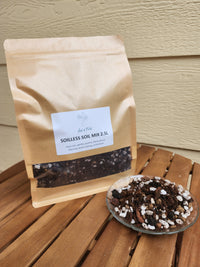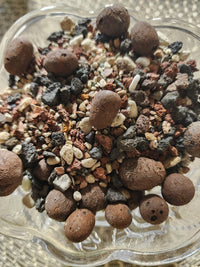Let's face it, even the most devoted plant parents encounter moments of leafy despair. Your once-thriving Fiddle Leaf Fig suddenly looks like a weeping willow, and your Snake Plant stretches for the sun like a disco dancer on roller skates.
Fear not, fellow green thumbs! We're here to navigate the jungle of common houseplant problems and equip you with the know-how to revive your botanical buddies.
Drooping Dilemmas:
The leaves on your beloved indoor plant are drooping and you're not sure why. Let's have a look at the three most common reasons that can make your plant leaves droop.
• Thirsty Traveler: A common and a tell tale sign is drooping leaves. Drooping leaves often scream "water me!" Check the soil moisture – if it's bone dry, give your plant a good drink. Preferably by standing it in a bowl of water. This can be from 5 minutes to half an hour, depending on the size of the plant. Beware of overwatering! Soggy soil can suffocate roots, leading to further droopiness. Aim for moist, not muddy, soil. A good tool to use is a moisture meter as it will take the guess work out!
• Sunshine Scrooge: The second reason for drooping leaves is light deprivation. Some plants, like Snake Plants, are happy in low light, but others crave a sunlit stage. If your light-loving friend is drooping, relocate them to a brighter spot. Remember, too much direct sun can scorch leaves, so find that sweet spot between sunshine and sauna. If you don't have the right spot for your planty friend, you can always supplement it with grow lights.
• Temperature Tantrums: The third reason for drooping leaves is stress. Drafts and extreme temperatures can stress your plant, leading to drooping. Keep them away from vents and air conditioners, and adjust the thermostat to a comfortable range.
Yellowing Foliage Frenzy:
The leaves on your houseplant are yellowing. Let's explore the 3 main reasons that can cause the leaves to yellow.
• Nutritional Needs: Are you feeding your plant? A number of planty people think that their plants don't need to be fed. This may be true if you've brought a plant with a slow release fertiliser. However, this fertiliser will wear off after few months. Hence, yellowing leaves can indicate nutrient deficiencies. Give your plant a gentle feeding with a balanced fertiliser. Click here to check out our recommended fertilisers.
• Sunlight Siesta: The light that your plant gets can also play a part in yellowing leaves. Both too much or too little light can cause leaves to yellow. Observe your plant's natural habitat and adjust its position accordingly. Remember, some plants show their displeasure with sudden light changes, so be gentle and slowly transition your plant!
• Overwatering Woes: The third main reason for yellowing leaves is overwatering. Excess water can drown roots, preventing them from absorbing nutrients. It is extremely important that you are using a well-draining soil for your houseplants. It's also important to ensure that your pot has plenty of drainage holes for excess water to drain. Adjust your watering according to the new soil.
Leggy Growth Lament:
Some of your indoor plants are looking a bit leggy (long and skinny stems). Let's have a look to see what could cause these long and skinny stems.
• Reaching for the Sun: The main reason for leggy growth is when you have the light on one side of the plant. Plants will reach out to the light like Olympic hopefuls in search for sunshine. Adjust your indoor plant position or supplement with grow lights. But beware of stretching them too quickly, as it can weaken the stem. It is also important to rotate your plant for even growth.
• Nutrient Napping: Again nutrients are an important component for your plant. Lack of nutrients can lead to weak, leggy growth. Give your plant a gentle feeding with a balanced fertiliser and ensure the soil is draining properly.
• Pot Party Pooper: When was the last time you repotted your beloved houseplant? A pot that's too small can restrict root growth, hindering overall development. Check if your plant is rootbound and repot in a larger container if needed.
Remember, every plant is an individual with its own quirks and preferences. Observe your leafy friend closely, identify the problem, and then take action. With a little TLC and these troubleshooting tips, you'll have your botanical buddies back to their vibrant, thriving selves in no time!
Bonus Tips: Keep a plant journal! Note down watering schedules, fertiliser applications, and light adjustments. This can help you identify patterns and tailor your care to your specific plant's needs.
Another tip is to use clear nursery pots. Clear nursery pots will help you to identify if your plant is dry or moist (watering needs), if your plant is root bound (needing a repot) and to just keep an eye on your plants root health. 😉
So, go forth, green warriors, and conquer those common houseplant hiccups! Your flourishing flora awaits!


